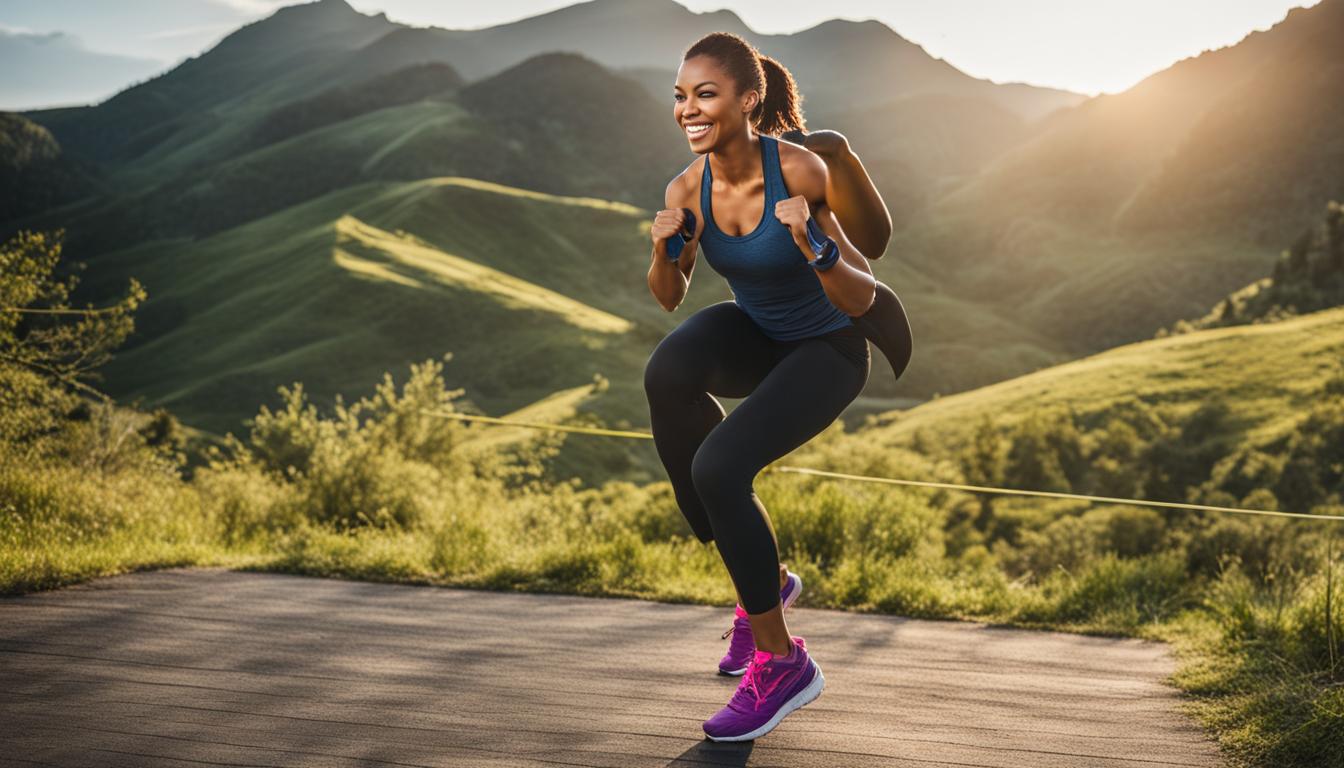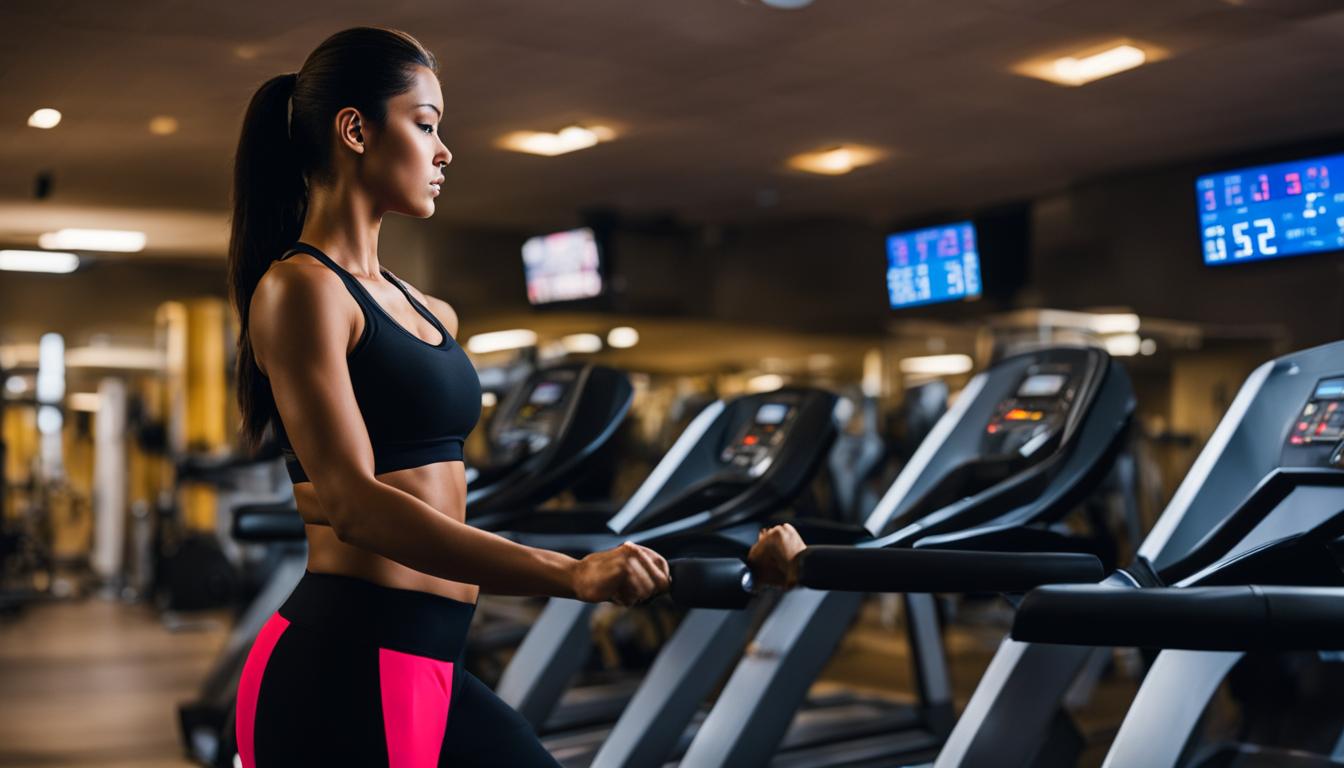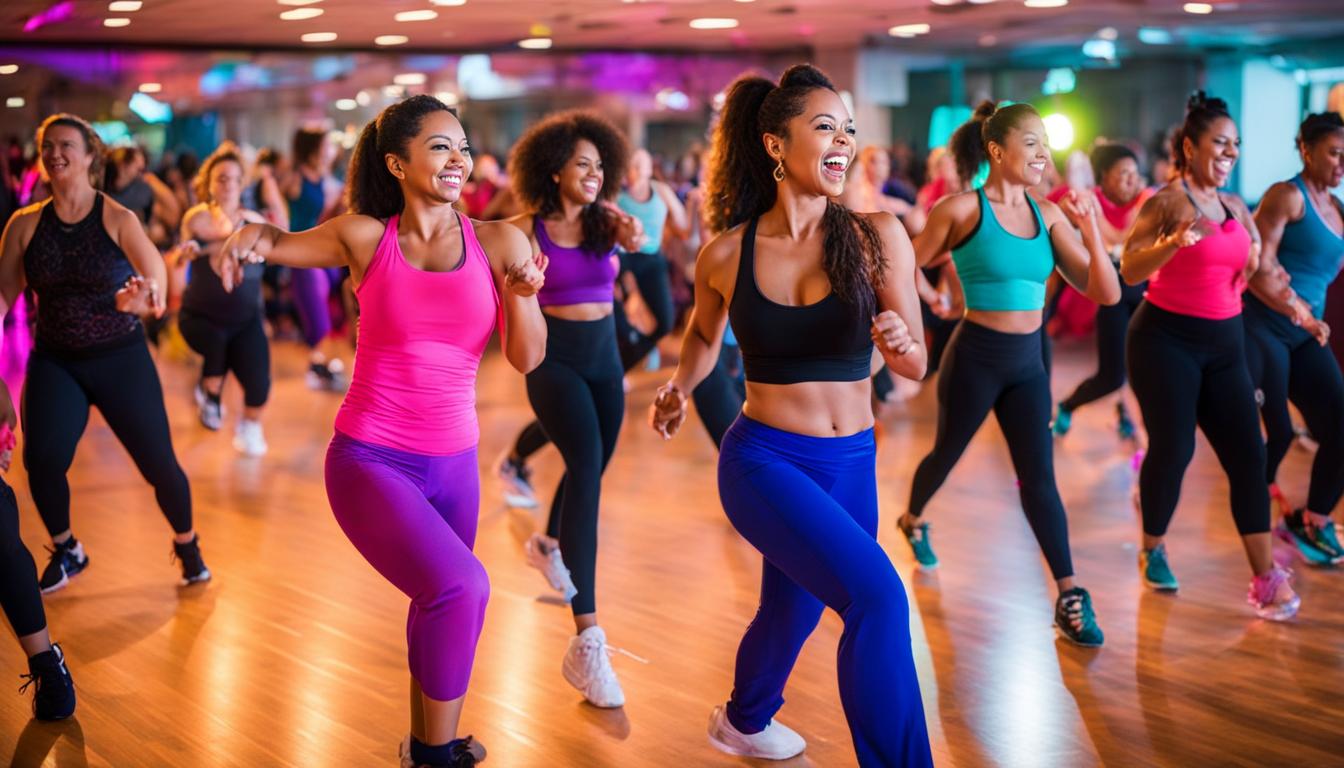Low-impact cardio workouts are a safe and effective way to burn fat without straining your joints. These workouts are suitable for beginners, those returning to exercise, or individuals with joint or injury concerns. Despite being low-impact, these workouts can still be intense and help you break a sweat. In this article, I will explore 5 low-impact cardio workouts that are great for burning fat and improving cardiovascular fitness.
Key Takeaways:
- Low-impact exercises provide a safe alternative for individuals with joint concerns.
- Low-impact cardio workouts can still be intense and effective for burning fat.
- Swimming, walking, rowing, cycling, and roller skating are great low-impact options.
- Incorporating low-impact strength training and aerobic exercises can further support weight loss goals.
- Low-impact workouts offer a balance between fat burning and joint protection.
Join a Gym and Go Swimming
Swimming, the king of joint-friendly low-impact exercises, is an excellent way to burn calories and improve cardiovascular fitness. The buoyancy of the water reduces stress on the body and supports your weight, making it an ideal workout for individuals with joint concerns. When you swim, you engage various muscle groups, including the upper and lower body, core, and shoulders, providing a full-body workout. Whether you’re a beginner or an experienced swimmer, incorporating swimming into your fitness routine can yield significant benefits.
On average, a 30-minute swimming session can burn approximately 216 to 252 calories, depending on your body weight. This makes swimming an effective low-impact cardio workout for those looking to shed excess pounds or maintain their weight. Additionally, the rhythmic nature of swimming and the calming effect of water create a peaceful environment that can reduce stress and promote mental well-being.
If you’re unsure where to start, consider joining a gym with a swimming pool. Many fitness centers offer swimming classes or have designated lanes for swimmers of all levels. Take advantage of the guidance and expertise of swimming instructors to improve your technique and maximize the benefits of your swimming workouts.
To visualize the calorie burn of swimming compared to other low-impact workouts, refer to the table below:
| Low-Impact Cardio Workout | Calories Burned (30 minutes) |
|---|---|
| Swimming | 216-252 |
| Walking | 175-189 |
| Rowing | 252-292 |
| Cycling | 252-294 |
| Roller Skating | 386-461 |
Swimming is a low-impact cardio workout that engages multiple muscle groups, burns calories, and provides cardiovascular and strength-training benefits.
Keep one foot on the ground and take a walk

Walking is a simple yet effective low-impact exercise that can be easily incorporated into your daily routine. It is easier on the knees compared to running or jogging and can be performed on various surfaces. To maximize calorie burn, focus on maintaining a brisk pace and incorporating high-intensity interval training (HIIT). This involves alternating between periods of faster walking and slower recovery walking. A 30-minute brisk walking session can burn approximately 175 to 189 calories, depending on body weight.
If you’re looking for an accessible and low-impact cardio workout, walking is an excellent choice. Not only does it help burn calories and improve cardiovascular health, but it also offers the opportunity to get outside and enjoy nature. Whether you walk around your neighborhood, a local park, or even on a treadmill, the benefits of walking are numerous.
Benefits of Walking:
- Low-impact exercise that is gentle on joints and reduces the risk of injury
- Improves cardiovascular fitness and strengthens the heart
- Burns calories and aids in weight loss
- Boosts mood and reduces stress
- Increases bone density and helps prevent osteoporosis
- Improves balance and coordination
High-Intensity Interval Training (HIIT) for Walking:
While walking is generally a low-intensity exercise, incorporating high-intensity interval training (HIIT) can add an extra calorie-burning boost. By alternating between periods of faster walking and slower recovery walking, you can increase the intensity and challenge your body. HIIT workouts are known for their ability to burn fat and improve cardiovascular fitness in a short amount of time.
“Incorporating high-intensity interval training (HIIT) into your walking routine can help you burn more calories and make the workout more challenging.”
During a HIIT walking workout, push yourself to walk as fast as you can for a designated period, such as 1 minute, then slow down to a comfortable pace for a recovery period of 1-2 minutes. Repeat this cycle for a set duration, such as 20-30 minutes. The intervals of increased intensity will elevate your heart rate and increase calorie burn.
| Walking Intensity | Calories Burned in 30 Minutes (Approx.) |
|---|---|
| Brisk Walking | 175 – 189 calories |
| HIIT Walking | Varies based on intensity, but potentially more than brisk walking |
Remember to warm up before starting your walk and cool down afterward. Stretching your muscles before and after can help prevent injuries and improve flexibility. Listen to your body and start at a pace and intensity that feels comfortable for you. As you build stamina and strength, gradually increase the duration and intensity of your walks.
So lace up your sneakers, step out, and start reaping the benefits of this low-impact, calorie-burning exercise. Whether you prefer a leisurely stroll or an energetic power walk, walking is a fantastic way to improve your fitness and overall well-being.
Focus on the rowing at the gym
When it comes to low-impact cardio workouts, rowing is a top choice for burning calories and strengthening your entire body. Rowing is a total-body exercise that provides both cardiovascular and strength training benefits, making it a versatile option for individuals with joint concerns.
Rowing machines can be found in most gyms, offering a convenient way to incorporate this low-impact exercise into your fitness routine. Alternatively, you can invest in a rower for home use, allowing you to row in the comfort of your own space.
Proper form is crucial for an effective rowing workout. When using a rowing machine, sit upright with your knees slightly bent and feet secured in the foot straps. Engage your core, drive through your legs, and pull the handle towards your chest, extending your arms back. Reverse the motion by pushing with your legs, leaning back slightly, and fully extending your arms forward.
During a 30-minute rowing session, you can burn approximately 252 to 292 calories, depending on your body weight. This makes rowing a highly efficient way to torch calories while engaging multiple muscle groups.
| Time | Calories Burned (based on body weight) |
|---|---|
| 30 minutes | 252 to 292 calories |
| 45 minutes | 378 to 438 calories |
| 60 minutes | 504 to 584 calories |
In addition to its calorie-burning benefits, rowing helps improve cardiovascular endurance, boost muscular strength and endurance, and enhance overall fitness levels. It targets the muscles of the legs, glutes, core, back, and arms, providing a full-body workout.
Whether you’re a beginner or a seasoned fitness enthusiast, rowing offers a low-impact option that delivers impressive results. Incorporate rowing into your exercise routine and experience the benefits of this efficient, calorie-burning workout.
Go for a spin
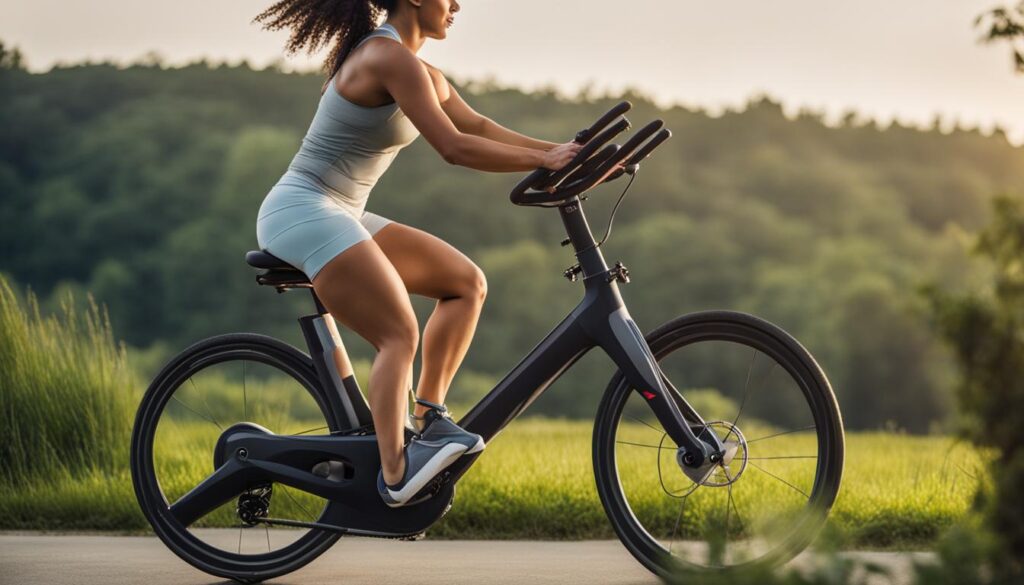
Cycling is a popular low-impact exercise that provides a similar intensity and cardiovascular benefits as running, without the joint impact. Whether you prefer pedaling on a stationary bike or hitting the road with a traditional bicycle, cycling is an excellent choice for a low-impact cardio workout.
When you cycle, you engage the muscles of your legs, heart, and lungs, making it an effective fat-burning exercise. It also helps improve endurance and stamina. Plus, cycling allows you to enjoy the outdoors and explore scenic routes, elevating your workout experience.
If you choose to cycle on a stationary bike, you can easily adjust the resistance to customize the intensity of your workout. This makes it suitable for individuals of all fitness levels, from beginners to advanced athletes.
On average, a 30-minute session on a stationary bike can burn approximately 252 to 294 calories, depending on your body weight. Outdoor cycling, particularly when incorporating hills or speed intervals, can burn even more calories and provide an additional challenge to your cardiovascular system.
| Activity | Time | Calories Burned* |
|---|---|---|
| 30-minute stationary bike session | 30 minutes | 252-294 calories |
| Outdoor cycling with hills or speed intervals | 30 minutes | Calories burned may vary* |
Remember to adjust your bike settings, such as seat height and handlebar position, to ensure proper alignment and minimize the risk of discomfort or injury. Additionally, wearing a helmet and appropriate cycling gear is essential for your safety.
So, why not go for a spin? Hop on your stationary bike or take your traditional bicycle for a ride and enjoy the benefits of a low-impact cardio workout.
Go for a skate
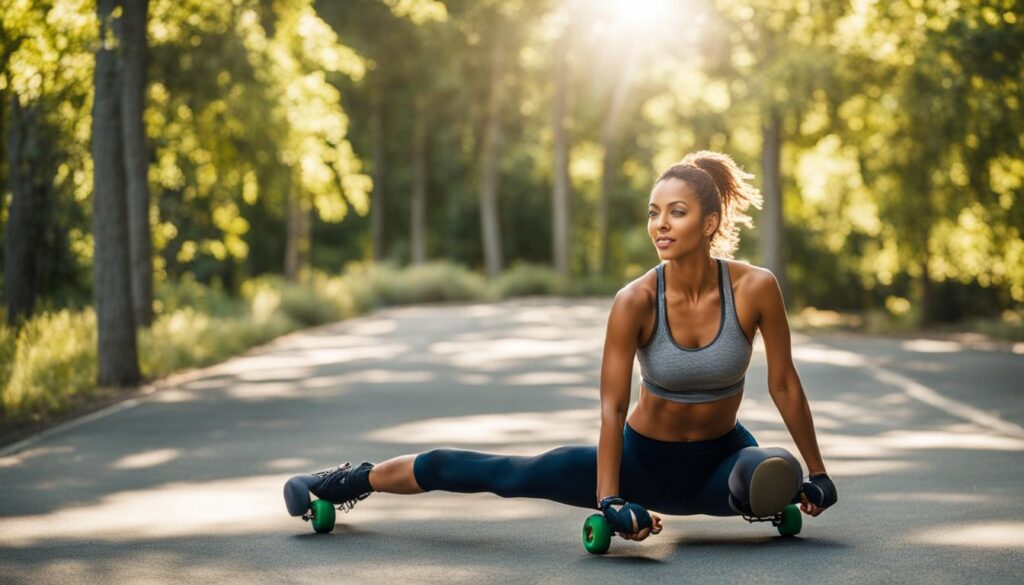
Roller skating is a fun and nostalgic low-impact exercise that can help you burn calories while having a great time. Unlike traditional front-to-back exercises like walking or running, roller skating offers a unique side-to-side motion that engages different muscles and adds variety to your workout routine.
When you roller skate, you target muscles in your lower body, including the glutes, hip abductors, and inner thighs. This makes it an effective way to strengthen and tone your lower body while enjoying the exhilarating feeling of gliding on wheels.
On average, a 30-minute roller skating session can burn approximately 386 to 461 calories, depending on your body weight. So lace up your skates and hit the rink or the pavement for a fun-filled workout that will leave you sweaty and smiling.
Why Choose Roller Skating?
Roller skating offers a range of benefits that make it an attractive choice for low-impact cardio workouts:
- Low impact: Roller skating is gentle on your joints, making it a suitable exercise for individuals with joint concerns or injuries.
- Fun and enjoyable: Roller skating is a recreational activity that brings back childhood memories and adds an element of excitement to your fitness routine.
- Cardiovascular fitness: Roller skating gets your heart pumping, improving cardiovascular health and endurance.
- Strength and coordination: The act of balancing on skates engages your core and leg muscles, helping to build strength and improve coordination.
So why not dust off those roller skates and give this low-impact workout a try? It’s a great way to have fun, burn calories, and stay active.
Yoga: Enhance Flexibility, Reduce Stress, and Find Balance
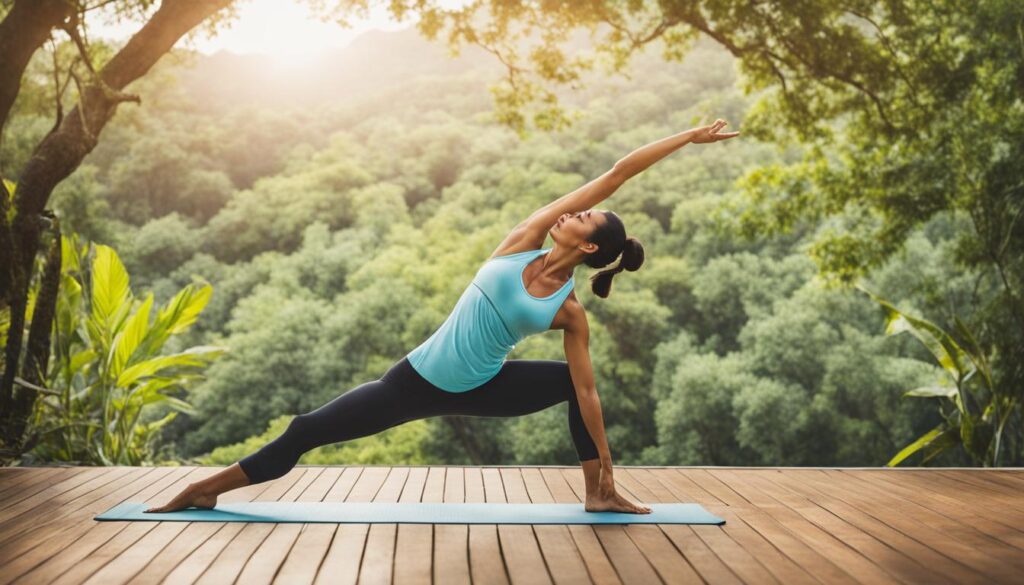
Yoga is a low-impact workout that encompasses a harmonious blend of deep breathing exercises, flowing movements, and gentle stretching. Its holistic approach not only improves flexibility and physical strength but also contributes to overall mental well-being. Incorporating yoga into your fitness routine can lead to reduced stress, anxiety relief, and alleviation of depression symptoms. Additionally, certain styles of yoga, such as hot or power yoga, offer more intense variations that can aid in weight loss and calorie burn.
Through a combination of mindful poses, controlled breathing, and focused meditation, yoga engages both the body and mind, promoting a sense of tranquility and inner peace. This ancient practice not only enhances physical flexibility but also cultivates mental flexibility, allowing practitioners to better adapt to the challenges of everyday life.
Unleash the transformative power of yoga and embark on a journey toward improved well-being and self-awareness. Find balance in both your body and mind by incorporating this low-impact workout into your regular fitness regimen.
The Benefits of Yoga:
- Improves flexibility and mobility
- Enhances strength and muscle tone
- Boosts cardiovascular health
- Calms the mind and reduces stress
- Promotes mindfulness and concentration
- Supports weight loss and calorie burn
“Yoga is not about touching your toes, it’s about what you learn on the way down.”
– Jigar Gor
Experience the transformative power of yoga and discover the numerous benefits it offers for both your physical and mental well-being. From increased flexibility and stress relief to enhanced strength and mindfulness, yoga provides a holistic approach to fitness that nourishes both the body and soul.
| Yoga Style | Calories Burned (per hour) |
|---|---|
| Hatha Yoga | 175-298 |
| Vinyasa Yoga | 298-597 |
| Ashtanga Yoga | 408-612 |
| Bikram (Hot) Yoga | 477-716 |
Note: Calorie burn values are approximate and vary depending on factors such as intensity, body weight, and individual metabolism.
Pilates

Pilates is a low-impact exercise that focuses on core strengthening and intentional movements. It is similar to yoga and promotes proper alignment, mindfulness, and mental health. Pilates can help ease back pain, improve posture, and provide overall body toning.
Developed by Joseph Pilates in the 20th century, this exercise method emphasizes controlled movements and proper breathing techniques. By engaging the core muscles, including the abdominals, back, and pelvic floor, Pilates improves core strength and stability. Strong core muscles contribute to better posture, balance, and overall body alignment.
One of the key principles of Pilates is precision. This means performing each movement with complete focus and attention to detail, allowing for maximum benefit and injury prevention. The slow and controlled nature of Pilates exercises helps to build strength and endurance without placing excessive strain on the joints.
Additionally, Pilates incorporates elements of flexibility training, promoting elongated muscles and improved range of motion. Regular practice can increase flexibility in both muscles and joints, reducing the risk of injuries and enhancing athletic performance.
With its emphasis on body awareness and proper alignment, Pilates can also be beneficial for improving posture. Many people spend long hours sitting at a desk or engaging in activities that contribute to poor posture. Pilates exercises help strengthen the muscles responsible for maintaining good posture, leading to a more upright and aligned physique.
Pilates can be practiced using specialized equipment such as reformers, cadillacs, and barrels, or through mat-based exercises that require only a yoga mat. Regardless of the equipment used, Pilates sessions typically involve a series of controlled movements and positions that target specific muscle groups.
Here are some common Pilates exercises for core strength, posture, and overall body toning:
- The Hundred
- Roll-Up
- Single Leg Stretch
- Double Leg Stretch
- Plank
- Swimming
- Bridge
- Leg Circles
When performing Pilates exercises, it is essential to focus on proper form and alignment. The guidance of a trained instructor can be beneficial, especially for beginners. They can ensure that exercises are being performed correctly and provide modifications if needed.
Whether you’re looking to strengthen your core, improve your posture, or enhance overall body tone, Pilates offers a low-impact workout option that can be tailored to your individual goals and fitness level.
Stay mindful, focus on your breath, and listen to your body as you embark on your Pilates journey. Enjoy the benefits of this holistic exercise method that promotes core strength, a balanced physique, and improved posture.
Pilates Exercise Examples
| Exercise | Targeted Muscles |
|---|---|
| The Hundred | Abdominals, Upper Body |
| Roll-Up | Abdominals, Spine |
| Single Leg Stretch | Abdominals, Hips |
| Double Leg Stretch | Abdominals, Hip Flexors |
| Plank | Core Muscles, Shoulders |
| Swimming | Back Muscles, Glutes |
| Bridge | Glutes, Hamstrings, Back Muscles |
| Leg Circles | Abdominals, Hip Flexors |
Brisk walking

Brisk walking is a convenient and accessible low-impact exercise that offers numerous health benefits. It can help reduce body fat, improve cardiovascular health, strengthen muscles, increase mood and energy levels, and improve balance.
Brisk walking is a low-impact workout that can be easily incorporated into your daily routine. It requires no equipment and can be done anywhere, making it a versatile option for individuals of all fitness levels. By briskly walking, you engage the muscles in your legs, hips, and core, improving muscle strength and tone.
One of the major benefits of brisk walking is its positive impact on cardiovascular health. It increases heart rate, improves circulation, and helps lower blood pressure, reducing the risk of heart disease and stroke. Regular brisk walking can also contribute to weight loss and maintenance by burning calories and increasing metabolism.
Aside from its physical benefits, brisk walking also has mental health benefits. It releases endorphins, the feel-good hormones, which can help reduce stress, anxiety, and depression. It enhances cognitive function, boosts creativity, and promotes overall mental well-being.
Moreover, brisk walking can significantly improve balance and coordination, making it particularly beneficial for older adults. It helps strengthen the muscles responsible for stability and reduces the risk of falls and injuries.
Incorporate brisk walking into your daily routine by aiming for at least 30 minutes of brisk walking on most days of the week. Start with a warm-up, gradually increase your speed, and finish with a cool-down. To make your brisk walking routine more engaging, consider exploring different routes, listening to music or podcasts, or walking with a companion.
Benefits of Brisk Walking:
- Reduces body fat
- Improves cardiovascular health
- Strengthens muscles
- Boosts mood and energy levels
- Enhances balance and coordination
Brisk walking is a low-impact workout that offers a wide range of health benefits. It is an excellent choice for individuals looking for a low-impact exercise option that is easy to incorporate into their daily lives.
Low-impact vs. high-impact workouts
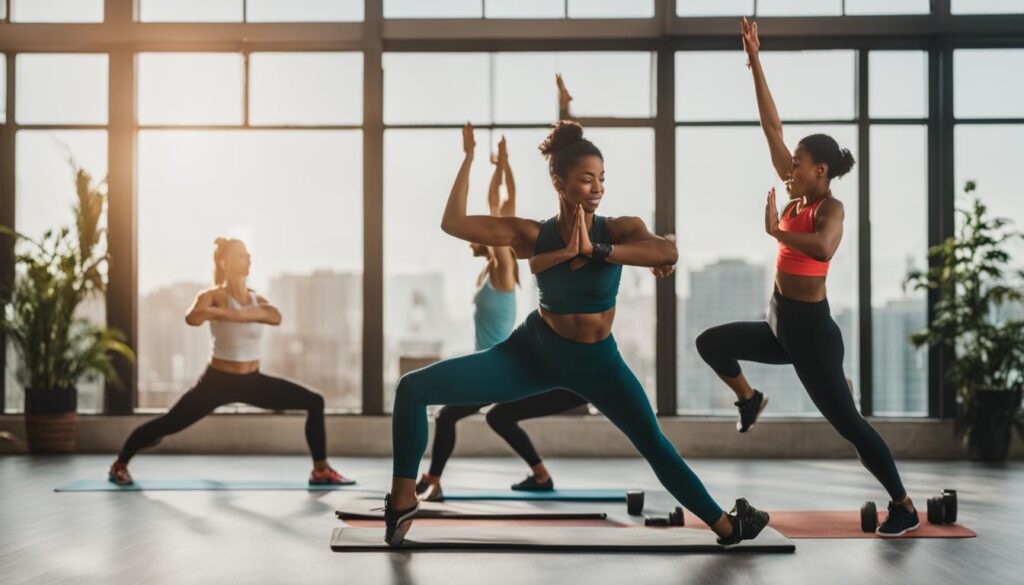
When it comes to choosing the right workout routine for your fitness goals, it’s important to understand the differences between low-impact and high-impact exercises. Both types of workouts have their own set of benefits and considerations. Let’s take a closer look at what sets them apart.
Low-impact exercises
Low-impact exercises are characterized by having at least one foot on the ground and minimal force on the joints. These workouts provide an excellent way to build muscle, burn fat, improve alignment, and enhance balance. They are ideal for individuals with joint sensitivities or those who are new to exercise. Low-impact exercises can be modified to suit different fitness levels and can provide a safe and effective way to improve overall fitness.
High-impact exercises
On the other hand, high-impact exercises involve more forceful movements and can be more intense in nature. These workouts offer a quicker calorie burn, improved bone density, and muscle building. High-impact exercises typically involve activities such as running, jumping, and plyometrics. While they can be highly effective for cardiovascular fitness and weight loss, they may not be suitable for everyone, especially those with joint issues or injuries.
Here’s a brief comparison between low-impact and high-impact exercises:
| Low-Impact Exercises | High-Impact Exercises |
|---|---|
| Minimal force on joints | More forceful movements |
| Safe for beginners and individuals with joint sensitivities | May not be suitable for those with joint issues or injuries |
| Muscle building and fat burning | Quicker calorie burn and improved bone density |
| Improved alignment and balance | Potential for muscle building |
When deciding between low-impact and high-impact exercises, it’s essential to consider your own fitness level, overall health, and any specific goals or limitations you may have. Consulting with a healthcare professional or certified fitness trainer can help you determine which type of workout is most appropriate for you.
By choosing the right workout routine that aligns with your needs and preferences, you can achieve your fitness goals while minimizing the risk of injury or discomfort. Whether you opt for low-impact exercises or high-impact workouts, the key is to listen to your body, start at a comfortable pace, and gradually increase the intensity as you build strength and endurance.
Conclusion
Low-impact workouts offer a highly effective and efficient way to burn fat and improve cardiovascular fitness without straining your joints. Incorporating exercises such as swimming, walking, rowing, cycling, and roller skating can help you achieve your fitness goals while minimizing the risk of joint injuries.
Low-impact cardio workouts like swimming utilize the buoyancy of water to reduce stress on your body while engaging multiple muscle groups. Brisk walking can be easily integrated into your daily routine and, when combined with high-intensity interval training, can maximize calorie burn. Rowing and cycling provide total-body workouts that promote cardiovascular fitness and strength training.
Apart from low-impact cardio exercises, options like yoga and Pilates offer opportunities for strength building and flexibility training. These exercises not only enhance physical fitness but also promote mental well-being. By incorporating a variety of low-impact workouts into your routine, you can enjoy the benefits of fat burning, improved cardiovascular health, and reduced joint strain.
Start incorporating low-impact exercises into your fitness routine today to achieve your goals while prioritizing the health and longevity of your joints. Embrace these enjoyable and effective workouts to burn fat, improve cardiovascular fitness, and elevate your overall well-being.

